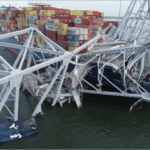A previously unknown fault in eastern Arkansas could trigger a magnitude 7 earthquake in the cotton fields of the upper South with an epicenter near a natural gas pipeline, a scientist said.
Haydar Al-Shukri, the director of the Arkansas Earthquake Center at the University of Arkansas at Little Rock, said the fault, west of Marianna, is separate from the New Madrid fault responsible for a series of quakes in 1811-12 that caused the Mississippi River to flow backward.
Acres of cotton cover the fault and stretches of fine sand mixed with fertile soil gave away the fault’s location, Al-Shukri said. Liquified sand bubbled up through cracks in the earth, while ground radar and digs showed vents that let the sand reach the surface, he said.
The fault, likely created in the last 5,000 years, sparked at least a magnitude 7 earthquake in its history. Such temblors cause massive destruction in their wake.
“This is a very, very dangerous (area) at risk of earthquake,” Al-Shukri said. “When you talk about 7 and plus, this is going to be a major disaster.”
Such a quake would affect Little Rock, some 100 miles to the west, as well as neighboring states like Mississippi and Tennessee, Al-Shukri said.
The researcher spoke to a crowd at the University of Arkansas’ Clinton School of Public Service after a number of minor temblors rattled the state in recent months.
He noted in his talk that a “major” gas pipeline crosses the fault near Marianna. A map made by the Arkansas Public Service Commission shows an Arkla Energy Resources pipe running through the area. Arkla was acquired by CenterPoint Energy Inc. several years ago.
Rebecca Virden, a spokeswoman for CenterPoint, said the company worked closely with public officials to prepare response plans for earthquakes and other natural disasters.
Pipes are “all over the place,” Virden said. “We, CenterPoint Energy, or someone else, has a pipeline everywhere.”
Clint Stephens, the chief of pipeline safety at the PSC, said the federal government would oversee any interstate lines. The U.S. Department of Transportation’s Office of Pipeline Safety did not immediately respond to a request for comment.
Carl Weimer, executive director of the Pipeline Safety Trust in Bellingham, Wash., said companies with lines running through earthquake-prone southern California include extra safety features.
“If they’re putting pipelines in fault lines, they still will lay them, but they may put more valves and different types of valves in case something happens and the pipeline can be shut off quicker,” Weimer said.
Hundreds of earthquakes occur each year and several happen in Arkansas. Most Arkansas earthquakes generally occur in the state’s northeast corner, part of the New Madrid Seismic Zone. During the winter of 1811 and 1812, a series of three earthquakes with magnitudes of around 8 struck the zone and much smaller temblors continue to hit today.
However, Al-Shukri said the Marianna fault was not connected to the New Madrid Seismic Zone, as it sat too far away from the cluster of small temblors caused by the zone that strike every year.
On the Net:
Arkansas Geological Survey: http://www.geology.ar.gov
UALR Arkansas Earthquake Center: http://quake.ualr.edu/
U.S. Geological Survey: http://www.usgs.gov
Topics Catastrophe Natural Disasters
Was this article valuable?
Here are more articles you may enjoy.


 Barge Looted in the Bahamas Returns to Florida but Insurance Claims Mounting
Barge Looted in the Bahamas Returns to Florida but Insurance Claims Mounting  The Hartford CEO Takes Lead in Shaping the City of Hartford’s Future
The Hartford CEO Takes Lead in Shaping the City of Hartford’s Future  Single Loose Wire Led to Blackout That Caused Dali Crash Into Baltimore Bridge
Single Loose Wire Led to Blackout That Caused Dali Crash Into Baltimore Bridge  AIG to Pay Neal $2.7 Million to Cover Previous Firm’s Bonus
AIG to Pay Neal $2.7 Million to Cover Previous Firm’s Bonus 

